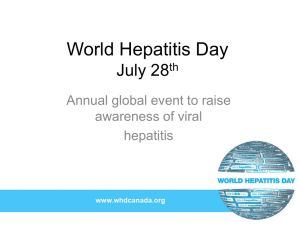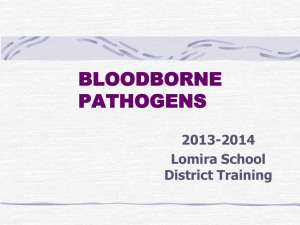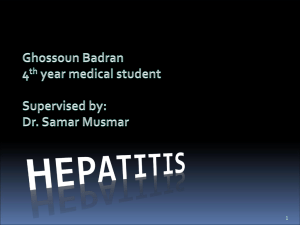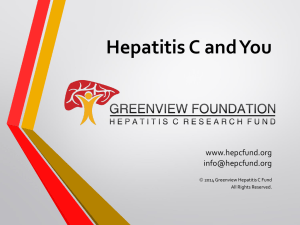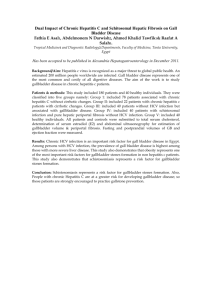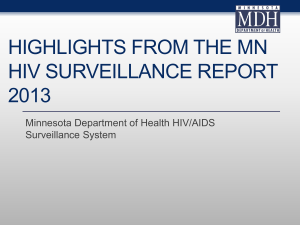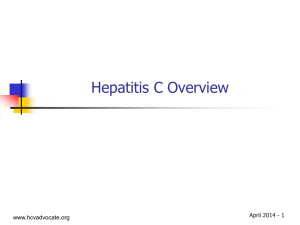African Americans and Hepatitis C
advertisement
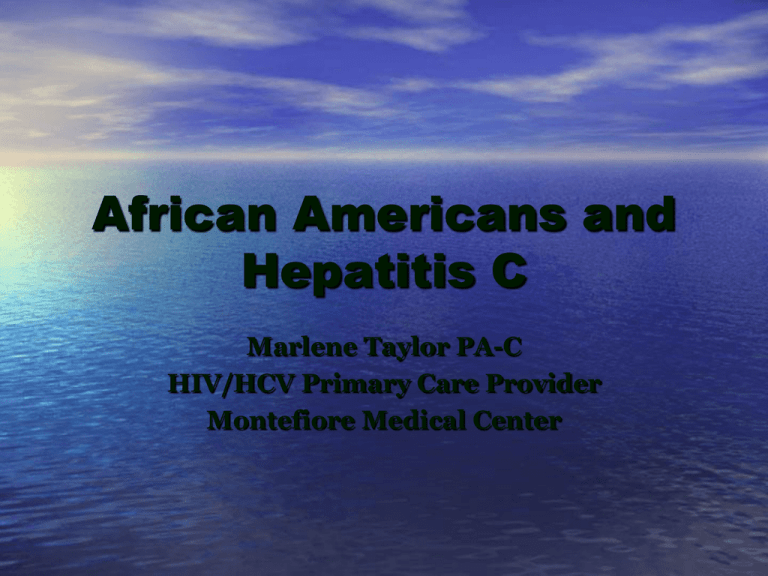
African Americans and Hepatitis C Marlene Taylor PA-C HIV/HCV Primary Care Provider Montefiore Medical Center • African Americans are twice as likely to be infected with the hepatitis C virus (HCV) compared to the general U.S. population, according to the CDC. While African Americans represent only 12 percent of the U.S. population, they make up roughly 22 percent of the estimated 3.2 million persons with chronic HCV infection. Moreover, chronic liver disease, often hepatitis C-related, is a leading cause of death among African Americans ages 45-64. Hepatitis C Facts • Hepatitis C is a liver disease caused by a virus. • Hepatitis C is usually spread when blood from a person infected with the hepatitis C virus enters the body of someone who is not infected. This can happen from sharing equipment for injecting drugs, receiving blood transfusions or organ transplants before 1992, getting a needlestick injury in health care settings, and even being born to a mother who has Hepatitis C. And some people don’t know how they got infected. Hepatitis C can spread through sexual intercourse, but it’s rare. • Anyone can get hepatitis C, but African Americans – as well as people born between 1945-1965, (“babyboomers” )– bear a disproportionate burden of disease. Hepatitis C Facts • Most people living with hepatitis C do not know they are • • • • • infected. The hepatitis C virus (HCV) can cause chronic hepatitis, in which the infection is prolonged, sometimes lifelong. Chronic hepatitis can lead to cirrhosis, liver failure, and liver cancer. In fact, viral hepatitis is the leading cause of liver cancer and the most common reason for liver transplantation. Most people living with HCV infection often have no symptoms until significant damage has been done. There is no vaccine to prevent hepatitis C infection. Getting tested is the only way to know if you have been exposed to hepatitis C. There are new and improved treatments exists for hepatitis C. Features of Hepatitis C Virus Infection Incubation period Range 2-26 weeks Acute illness (jaundice) Chronic infection Cirrhosis Mortality from CLD Liver Cancer Average 6-7 weeks Mild (<20%) 75%-85% 10%-20% 1%-5% 1% Serologic Pattern of Acute HCV Infection with Progression to Chronic Infection antiHCV Symptoms +/- Titer HCV RNA ALT Normal 0 1 2 3 4 Months 5 6 1 Time after Exposure 3 2 Years 4 Transmission of HCV – Injecting drug use – Blood Transfusion, transplant from infected donor,(before screening available in 1992 ) – Therapeutic (contaminated equipment, unsafe injection practices) – Occupational (needlestick) – Perinatal (mother to child) – Sexual – Sharing Contaminated items with infected blood( ie toothbrush, razor, ) Signs and Symptoms • Persons with newly acquired HCV infection usually are • • • • • • • • • • asymptomatic or have mild symptoms that are unlikely to prompt a visit to a health care professional. When symptoms occur, they can include Fever Fatigue Dark urine Clay-colored stool Abdominal pain Loss of appetite Nausea Vomiting Joint pain Jaundice Signs and Symptoms Most persons with chronic HCV infection are asymptomatic. However, many have chronic liver disease, which can range from mild to severe, including cirrhosis and liver cancer. Chronic liver disease in HCVinfected persons is usually insidious, progressing slowly without any signs or symptoms for several decades. In fact, HCV infection is often not recognized until asymptomatic persons are identified as HCV-positive when screened for blood donation or when elevated alanine aminotransferase (ALT, a liver enzyme) levels are detected during routine examinations. Medical Work up • History and Physical • • • • • • • • • HCV antibody result Hepatitis C Viral RNA if HCVab + Check HIV status HepA ab /HepBsab status – vaccinate if neg Liver enzymes(ALT/AST SGOT/SGPT) Metabolic panel (check glucose, kidney fct) Genotype Abdominal ultrasound Liver Biopsy +/- Progression of Fibrosis on Biopsy No Fibrosis Stage 1: Fibrous expansion of some portal areas Stage 3: Fibrous expansion of most portal areas with occasional portal to portal bridging Courtesy of Gregory Everson, MD. Stage 4: Fibrous expansion of portal areas with marked bridging (portal to portal and portal to central) Stage 5,6: Cirrhosis, probable or defined Cirrhotic liver: Gross anatomy of cadaver Challenges • • • • • • • • • Genotype Fewer Blacks in Clinical trials Stigma Co morbid conditions Neutropenia Disease progression (Fibrosis) Treatment Response IL28B Access to care/ Insurance/ Treatment • Important to understand that currently available treatment must be • • • • • • • • individualized –(treatment experienced or naïve, genotype, liver bx etc) Early 2000-Combination therapy Pegylated interferon, and ribavirin, 2011 in addition to the above two protease drugs (Bocepravir or Telapravir FDA approved and one combined with peg and riba for treatment, Studies show that currently available treatment improved because of shorter duration Better clincal outcomes (SVR’s) Improved tolerability, less side effects Treatment is defined as undetectable HCV RNA in the patient's blood 24 weeks after the end of treatment At least six distinct HCV genotypes (genotypes 1–6) and more than 50 subtypes have been identified. Genotype 1 is the most common HCV genotype in the United States and the most common in African Americans. Patients with genotypes 2 and 3 are almost three times more likely than patients with genotype 1 to respond to therapy DAA Combinations Phase III (without interferon Drug Name/ Category Drug Name/ Category CompanyVerifiedABT-450/r (Protease Inhibitor)ABT-267 (NS5A Inhibitor) and/or ABT-333 (Polymerase Inhibitor)Abbott / EnantaJuly 3, 2013 Daclatasvir (BMS-790052) (NS5A Inhibitor)Asunaprevir (BMS-650032) (Protease Inhibitor)Bristol-Myers SquibbJuly 3, 2013 Faldaprevir (BI 201335) Protease InhibitorDeleobuvir BI 207127 Polymerase Inhibitor Boehringer IngelheimJuly 3, 2013 Sofosbuvir (GS-7977) (Polymerase Inhibitor)Ledipasvir (GS-5885) (NS5A Inhibitor)GileadJuly 3, 2013 Phase III (with PegINF plus RBV • Phase III (with PegINF plus RBV) Drug Name Drug Category CompanyVerifiedDaclatasvir (BMS-790052)NS5A Inhibitor Bristol-Myers SquibbJuly 3, 2013 Faldaprevir (BI 201335)Protease Inhibitor Boehringer IngelheimJuly 3, 2013 Simeprevir (TMC435)Protease Inhibitor JanssenJuly 3, 2013 Sofosbuvir (GS-7977)Polymerase Inhibitor GileadJuly 3, 2013 Case • RT is a 26 yo AA female who presented to the local medical clinic for a routine physical . Her previous clinic “closed down “ and she needs an exam to return to school and work. • • • • • PMH- Denies DM, HTN, CVS Ds, Pneumnia, Asthma or TB, last PPD 2011 negative, Gyn Hx- G0 P0 – last pap neg, Neg HPV 2012 ,sexually active , heterosexual with 2 partners, uses condoms ‘”most of the time” No h/o GC, Chlamydia or HSV, tested HIV negative 2010 ROS- tired most of the time for past 3- 4 yrs , generalized itching on and off, occ nausea , no fevers diarrhea or wgt loss, has good appetite despite intermittent nausea is able to go to school and work. Allergies- NKA Meds- Multivitamin daily Social Hx- single, P/T college student x 2 yrs, F/T work as unit clerk in local hospital x 5 years, no h/o smoking , +Social drinker once a moth with the girls” few glasses wine” , no h/o IVDA or illicit drug use. Hobbies include being a Big Sister to a 9 yo girl twice a month who sleeps over “sometimes she forgets to bring toiletries but I keep a supply of mine for her” Family Hx- Mother and Father both deceased AIDS related complications 1992, 5 siblings 1 she recalls with “yellow jaundice” as a child Case • • • • • • • • • • • • • PE : Thin AA female in NAD vital signs stable HEENT- anicteric, throat clear no lymph node enlargement Lungs- clear CVS- S1 S2 Abdomen- soft + BS, slight RUQ tenderness, no hepatomegaly no spleenomegaly, no fluid wave Extremity- no clubbing cyanosis or edema, no palmar erythema Neuro- no deficits Skin- no rashes or petichiae no spider angiomas Mental status- pleasant, alert, oriented , appropriate Genitalia- wnl no lesions or rashes Pelvic –no d/c , no cmt, no lesions or adnexal tenderness Ut antverted nl size Labs • • • • • • • • • • • • CBC and PLT’s - wnl Metabolic Panel-wnl LFT- elevated ALT (83), AST (37) alk phos112 HepAsab-Negative HepBsag- Negative/ HepBsab- Positive HCV Ab- positive RPR- Non reactive Urine GC and Chlamydia - negative Urinalysis – wnl Quantiferon – negative Pap- negative malignant cells , negative HPV Questions • What is the diagnosis in this patient? • What was the most likely mode of transmission? • What are the next diagnostic steps in her medical work • • • • up? Is she cleared to go to return to school? to work? What would you advise this patient to do immediately? Would you refer this patient to a specialist for treatment ? Why or why not? What important information is missing in the history essential for the management of this patient? Despite the seriousness of this health problem in the African American community, too few African Americans know about the disease or get tested for it. Early detection of chronic viral hepatitis infection can save lives,” observes Dr. Ronald Valdiserri, MD, MPH, Deputy Assistant Secretary for Health, Infectious Diseases and Director, Office of HIV/AIDS and Infectious Disease Policy at the U.S. Department of Health and Human Services Thank You! Marlene Taylor PA-C mataylor@montefiore.org 718 920-8542



